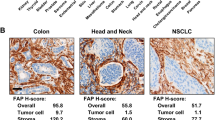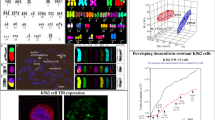Abstract
Purpose
3′-[18F]fluoro-3'-deoxythymidine ([18F]FLT) is phosphorylated by thymidine kinase 1 (TK-1), a cell cycle regulated enzyme. Appropriate use of [18F]FLT tracer requires validation of the TK-1 activity. Here, we report development of a novel phosphoryl-transfer assay to assess phosphorylation of [18F]FLT both in tumor cell lysates and tumor cells.
Procedures
The intrinsic F-18 radioactivity was used to quantify both substrate and phosphorylated products using a rapid thin layer chromatography method. Phosphorylation kinetics of [18F]FLT in SW480 and DiFi tumor cell lysates and cellular uptake were measured.
Results
The apparent Michaelis–Menten kinetic parameters for [18F]FLT are \( {K_{\rm{m}}} = {4}.{8}\pm 0.{3}\;{{\mu M}} \) and V max = 7.4 pmol min−1 per 1 × 106 cells with ∼2-fold higher TK-1 activity in DiFi versus SW480 lysates.
Conclusions
The apparent K m of [18F]FLT was comparable to the value reported with purified recombinant TK-1. The uptake of [18F]FLT by SW480 cells is inhibited by nitrobenzylthioinosine or dipyridamole indicating that uptake is mediated predominantly by the equilibrative nucleoside transporters in these tumor cells.





Similar content being viewed by others
References
Kenny LM, Aboagye EO, Price PM (2004) Positron emission tomography imaging of cell proliferation in oncology. Clin Oncol 16:176–185
Shield AF (2003) PET imaging with 18F-FLT and thymidine analogs: promise and pitfalls. J Nucl Med 44:1432–1434
Been LB, Suurmeijer AJH, Cobben DCP, Jager PL, Hoekstra HJ, Elsinga PH (2004) [18F]FLT-PET in oncology: current status and opportunities. Eur J Nucl Med Mol Imaging 31:1659–1672
Giovanni L (2006) Imaging in cancer therapy and drug development. Eur J Nucl Med Mol Imaging 33:386–388
Shield AF, Grierson JR, Dohmen BM, Machulla H-J, Stayanoff JC, Lawhorn-Crews JM, Obradovich JE, Muzik O, Mangner TJ (1998) Imaging proliferation in vivo with [F-18]FLT and positron emission tomography. Nat Med NY 4:1334–1336
Reske SN, Deisenhofer S (2006) Is 3′-deoxy-3′-18F-fluorothymidine a better marker for tumour response than 18F-fluorodeoxyglucose? Eur J Nucl Med Mol Imaging 33(13):38–43
Herrmann K, Wieder HA, AK AKB, Schoffel M, Krause B-J, Fend F, Schuster T, Buschenfelde CMZ, Wester H-J, Duyster J, Peschel C, Schwaiger M, Dechow T (2007) Early response assessment using 3′-deoxy-3′-[18F]fluorothymidine-positron emission tomography in high-grade non-Hodgkin's lymphoma. Clin Cancer Res 13:3552–3558
Kenny L, Coombes RC, Vigushin DM, Al-Nahhas A, Shousha S, Aboagye EO (2007) Imaging early changes in proliferation at 1 week post chemotherapy: a pilot study in breast cancer patients with 3′-deoxy-3′-[18F]fluorothymidine positron emission tomography. Eur J Nucl Med Mol Imaging 34:1339–1347
Sohn HJ, Yang YJ, Ryu JS, Oh S, Im KC, HyukMoon D, Lee DH, Suh C, Lee JS, Kiml SW (2008) [18F]Fluorothymidine positron emission tomography before and 7 days after gefitinib treatment predicts response in patients with advanced adenocarcinoma of the lung. Clin Cancer Res 14:7423–7429
Krohn KA, Mankoff DA, Eary JF (2001) Imaging cellular proliferation as a measure of response to therapy. J Clin Pharmacol 41:96S–103S
Buck AK, Kratochwil C, Glatting G, Juweid M, Bommer M, Tepsic D, Vogg AT, Mattfeldt T, Neumaier B, Moller P, Reske SN (2007) Early assessment of therapy response in malignant lymphoma with the thymidine analogue [18F]FLT. Eur J Nucl Med Mol Imaging 34:1775–1782
Chen W, Delaloye S, Silverman DH, Geist C, Czernin J, Sayre J, Satyamurthy N, Pope W, Lai A, Phelps ME, Cloughesy T (2007) Predicting treatment response of malignant gliomas to bevacizumab and irinotecan by imaging proliferation with [18F] fluorothymidine positron emission tomography: a pilot study. J Clin Oncol 25:4714–4721
Manning HC, Merchant NB, Foutch AC, Virostko JM, Wyatt SK, Shah C, McKinley ET, Xie J, Mutic NJ, Washington MK, LaFleur B, Tantawy MN, Peterson TE, Ansari MS, Baldwin RM, Rothenberg ML, Bornhop DJ, Gore JC, Coffey RJ (2008) Molecular imaging of therapeutic response to epidermal growth factor receptor blockade in colorectal cancer. Clin Cancer Res 14:7413–7422
Ullrich RT, Zander T, Neumaier B, Koker M, Shimamura T, Waerzeggers Y, Borgman CL, Tawadros S, Li H, Sos ML, Backes H, Shapiro GI, Wolf J, Jacobs AH, Thomas RK, Winkeler A (2008) Early detection of erlotinib treatment response in NSCLC by 3′-deoxy-3′-[18F]-fluoro-l-thymidine ([18F]FLT) positron emission tomography (PET). PLoS ONE 3:e3908
Rasey JS, Grierson JR, Wiens LW, Kilb PD (2002) Validation of FLT uptake as a measure of thymidine kinase-1 activity in A549 carcinoma cells. J Nucl Med 43:1210–1217
Seitz U, Wagner M, Neumaier B, Wawra E, Glatting G, Leder G, Schmid RM, Reske SN (2002) Evaluation of pyrimidine metabolising enzymes and in vitro uptake of 3′-[(18)F]fluoro-3′-deoxythymidine ([(18)F]FLT) in pancreatic cancer cell lines. Eur J Nucl Med Mol Imaging 29:1174–1181
Barthel H, Perumal M, Latigo J, He Q, Brady F, Luthra SK, Price PM, Aboagye EO (2005) The uptake of 3′-deoxy-3′-[18F]fluorothymidine into L5178Y tumours in vivo is dependent on thymidine kinase 1 protein levels. Eur J Nucl Med Mol Imaging 32:257–263
Al-Madhoun AS, Johnsamuel J, Barth RF, Tjarks W, Eriksson S (2004) Evaluation of human thymidine kinase 1 substrates as new candidates for boron neutron capture therapy. Cancer Res 64:6280–6286
Lunato AJ, Wang J, Woollard JE, Anisuzzaman AK, Ji W, Rong FG, Ikeda S, Soloway AH, Eriksson S, Ives DH, Blue TE, Tjarks W (1999) Synthesis of 5-(carboranylalkylmercapto)-2′-deoxyuridines and 3-(carboranylalkyl)thymidines and their evaluation as substrates for human thymidine kinases 1 and 2. J Med Chem 42:3378–3389
Toyohara J, Hayashi A, Gogami A, Hamada M, Hamashima Y, Katoh T, Node M, Fujibayashi Y (2006) Alkyl-fluorinated thymidine derivatives for imaging cell proliferation I. The in vitro evaluation of some alkyl-fluorinated thymidine deriv. Nucl Med Biol 33:751–764
Byun Y, Yan J, Al-Madhoun AS, Johnsamuel J, Yang W, Barth RF, Eriksson S, Tjarks W (2005) Synthesis and biological evaluation of neutral and zwitterionic 3-carboranyl thymidine analogues for boron neutron capture therapy. J Med Chem 48:1188–1198
Johnsamuel J, Lakhi N, Al-Madhoun AS, Byun Y, Yan J, Eriksson S, Tjarksa W (2004) Synthesis of ethyleneoxide modified 3-carboranyl thymidine analogues and evaluation of their biochemical, physicochemical, and structural properties. Bioorg Med Chem 12:4769–4788
Byun Y, Yan J, Al-Madhoun AS, Johnsamuel J, Yang W, Barth RF, Eriksson S, Tjarksa W (2004) The synthesis and biochemical evaluation of thymidine analogues substituted with nido carborane at the N-3 position. Appl Radiat Isot 61:1125–1130
Zhang F, Shao X, Li H, Robison JG, Murray BK, O'Neill KL (2001) A monoclonal antibody specific for human thymidine kinase 1. Hybridoma 20:25–34
Baldwin SA, Mackey JR, Cass CE, Young JD (1999) Nucleoside transporters: molecular biology and implications for therapeutic development. Mol Med Today 5:216–224
Damaraju VL, Damaraju S, Young JD, Baldwin SA, Mackey J, Sawyer MB, Cass CE (2003) Nucleoside anticancer drugs: the role of nucleoside transporters in resistance to cancer chemotherapy. Oncogene 22:7524–7536
King AE, Ackley MA, Cass CE, Young JD, Baldwin SA (2006) Nucleoside transporters: from scavengers to novel therapeutic targets. Trends Pharmacol Sci 27:416–425
Zhang J, Visser F, King KM, Baldwin SA, Young JD, Cass CE (2007) The role of nucleoside transporters in cancer chemotherapy with nucleoside drugs. Cancer Metastasis Rev 26:85–110
Perumal M, Pillai RG, Barthel H, Leyton J, Latigo JR, Forster M, Mitchell F, Jackman AL, Aboagye EO (2006) Redistribution of nucleoside transporters to the cell membrane provides a novel approach for imaging thymidylate synthase inhibition by positron emission tomography. Cancer Res 66:8558–8564
Machulla HJ, Blocher A, Kuntzsch M, Piert M, Wei R, Grierson JR (2000) Simplified labeling approach for synthesizing 3′-deoxy-3′-[18F]fluorothymidine ([18F]FLT). J Radioanal Nucl Chem 243:843–846
Reischl G, Blocher A, Wei R, Ehrlichmann W, Kuntzsch M, Solbach C, Dohmen BM, Machulla H-J (2006) Simplified, automated synthesis of 3′-[18F]fluoro-3′-deoxythymidine ([18F]FLT) and simple method for metabolite analysis in plasma. Radiochim Acta 94:447–451
Manning HC, Merchant NB, Foutch AC, Virostko JM, Wyath SK, Shah C, McKinly ET, Xie J, Mutic NJ, Washington MK, LaFleur B, Tantawy MN, Peterson TE, Ansari MS, Baldwin RM, Rothenberg ML, Bornhop DJ, Gore JC, Coffey RJ (2008) Molecular imaging of therapeutic response to epidermal growth factor receptor blockade in colorectal cancer. Clin. Cancer Res 14, 7413–7422
Olive M, Untawale S, Coffey RJ, Siciliano MJ, Wildrick DM, Fritsche H (1993) Characterization of the DiFi rectal carcinoma cell line derived from a familial adenomatous polyposis patient. In Vitro Cell Dev Biol 29A:239–248
He Q, Skog S, Welander I, Tribukait B (2002) X-irradiation effects on thymidine kinase (TK): II. The significance of deoxythymidine triphosphate for inhibition of TK1 activity. Cell Prolif 35:83–92
Buursma A, van Dillen I, van Waarde A, Vaalburg W, Hospers G, Mulder N, de Vries E (2004) Monitoring HSVtk suicide gene therapy: the role of [(18)F]FHPG membrane transport. Br J Cancer 91:2079–2085
Munch-Petersen B, Cloos L, Jensen H, Tyrsted G (1995) Human thymidine kinase 1. Regulation in normal and malignant cells. Adv Enzyme Regul 35:69–89
Grierson JR, Schwartz JL, Muzi M, Jordan R, Krohn KA (2004) Metabolism of 3′-deoxy-3′-[F-18]fluorothymidine in proliferating A549 cells: validations for postron emission tomography. Nucl Med Biol 31:829–837
Munch-Petersen B, Cloosll L, Tyrstedn G, Eriksson S (1991) Diverging substrate specificity of pure human thymidine kinase 1 and 2 aginst antiviral dideoxynucleosides. J Biol Chem 266:9032–9038
Schaer J, Maurer U, Schindler R (1978) Determination of thymidine in serum used for cell culture media. Exp Cell Biol 46:1–10
Gentry GA, Morse PAJ, Ives DH, Gebert R, Potter VR (1965) Pyrimidine metabolism in tissue culture cells derived from rat hepatomas II. Thymidine uptake in suspension cultures derived from the novikoff hepatoma. Cancer Res 25:509–516
Kong X-B, Zhu Q-Y, Vidal PM, Watanabe KA, Polsky B, Amstrong D, Ostrander M, JR SAL, Muchmore E, Chou T-C (1992) Comparisons of anti-human Immunodeficiency virus activities, cellular transport, and plasma and intracellular pharmacokinetics of 3′-fluoro-3′-deoxythymidine and 3′-azido-3′ deoxythymidine. Antimicrob Agents Chemother 35:808–818
Alauddin MM, Conti PS, Fissekis JD (2003) A general synthesis of 2′-deoxy-2′-[18F]fluoro-1-β-d-arabinofuranosyluracil and its 5-substituted nucleosides. J Label Compd Radiopharm 46:285–289
Acknowledgements
The authors thank Dr. Roger Colbran for advice on the use of NaF as a general phosphatase inhibitor in the phosphoryl-transfer assay and both Jeffrey Clanton and Jarrod Driskill for cyclotron-produced [18F]fluoride. This work was supported by grants from National Institutes of Health, NIH/NCI R25T-CA092043, NIH 5R21MH073800-02, the GI Special Program of Research Excellence (P50 95103), ICMIC (P50CA128323), the NCI-funded South-Eastern Center for Small-Animal Imaging, (U24CA126588), Vanderbilt Department of Radiology & Radiological Sciences and Department of Cancer Biology. H. Charles Manning acknowledges support from a Career Development Award from the National Cancer Institute (K25CA 127349).
Author information
Authors and Affiliations
Corresponding author
Rights and permissions
About this article
Cite this article
Guo, N., Xie, J., Charles Manning, H. et al. A Novel In Vitro Assay to Assess Phosphorylation of 3′-[18F]fluoro-3′-Deoxythymidine. Mol Imaging Biol 13, 257–264 (2011). https://doi.org/10.1007/s11307-010-0351-8
Published:
Issue Date:
DOI: https://doi.org/10.1007/s11307-010-0351-8




